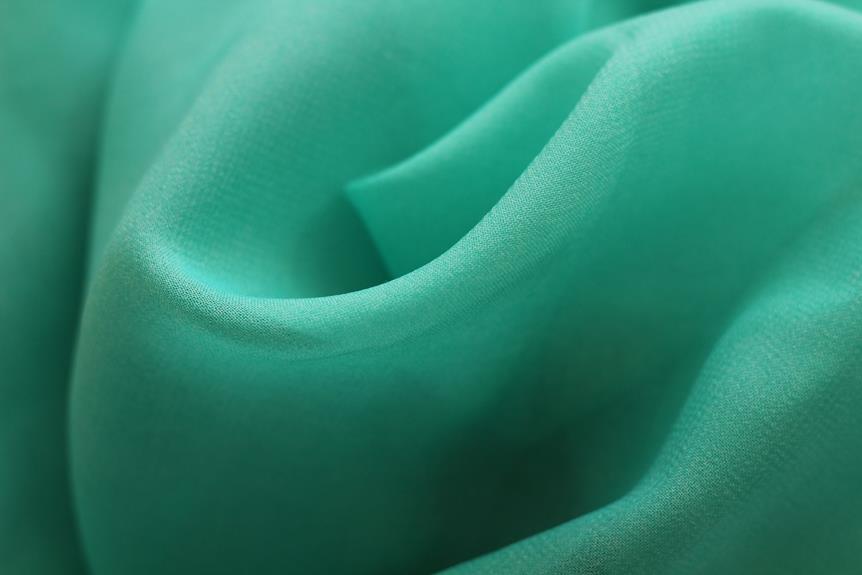Looking to brighten up your polyester fabrics without the hassle? You're in luck!
With these 5 easy methods, you can effortlessly restore the whiteness of your polyester garments and linens.
From the natural power of lemon juice and baking soda to the gentle effectiveness of hydrogen peroxide, there's a solution for every fabric care need.
No need to stress about dingy whites when you have these mastery-level techniques at your fingertips.
Say goodbye to dullness and hello to brilliantly white polyester with these simple yet effective methods.
Key Takeaways
- Lemon juice and baking soda mixture can effectively brighten and whiten polyester fabric.
- Hydrogen peroxide solution is great for removing tough stains like coffee, tea, or wine from polyester fabric.
- Oxygen-based bleach solution is an effective method for brightening and whitening polyester fabric.
- Vinegar and borax soak can revitalize the color of polyester fabric without fading the color.
Lemon Juice and Baking Soda Method
You can easily whiten polyester fabric using the lemon juice and baking soda method. When it comes to fabric care, natural remedies like this one are a game-changer.
To start, mix 1/2 cup of lemon juice and 1/2 cup of baking soda in a large bucket or basin. Stir the solution until the baking soda is fully dissolved.
Then, submerge the polyester fabric in the mixture, making sure it's fully saturated. Let it soak for at least an hour, but preferably overnight for more stubborn stains.
After soaking, wash the fabric as you normally would, but avoid using hot water as it can set any remaining stains. This natural remedy is effective in brightening and whitening polyester fabric, and it's gentle on the fibers, making it a great option for fabric care.
This method is a fantastic way to naturally whiten polyester fabric without the use of harsh chemicals. The combination of lemon juice and baking soda works to lift stains and brighten the fabric, leaving it looking fresh and clean.
Incorporating natural remedies into your fabric care routine not only helps to maintain the quality of the fabric but also reduces the use of potentially harmful chemicals.
Hydrogen Peroxide Soak
To continue the discussion from the previous subtopic, simply mix 1 part hydrogen peroxide with 2 parts water in a basin or large container. Before soaking your polyester fabric, it's crucial to check for color fastness. Test a small, inconspicuous area of the fabric by applying a small amount of the hydrogen peroxide solution and observing for any color changes or fading. If the color remains stable, proceed with soaking the fabric.
When using the hydrogen peroxide soak method, it's important to consider stain removal. This method is particularly effective at removing tough stains, such as those from coffee, tea, or wine. Allow the fabric to soak in the hydrogen peroxide solution for 30 minutes to 1 hour, depending on the severity of the stains. After soaking, wash the fabric as usual, following the care instructions on the garment's label.
Remember that while hydrogen peroxide is an excellent whitening agent for polyester, it should be used with caution. Avoid prolonged soaking as it can weaken the fabric over time. Additionally, always test for color fastness and consider spot treating stains before resorting to a full soak.
Oxygen-Based Bleach Solution
When whitening polyester fabric, start by mixing the oxygen-based bleach solution according to the package instructions.
Oxygen-based bleach is a powerful tool for fabric care and stain removal techniques. It's effective at brightening and whitening polyester fabric without causing damage.
Once the solution is prepared, submerge the polyester fabric in the solution and let it soak for the recommended duration. This allows the oxygen-based bleach to penetrate the fabric and lift any stains or discoloration.
After soaking, thoroughly rinse the fabric with cold water to remove the bleach solution. It's important to follow up with a gentle detergent wash to ensure all the bleach is removed.
Remember to always check the care label of the polyester fabric before using any bleach or stain removal products. Additionally, it's a good practice to spot test a small, inconspicuous area of the fabric to ensure that the bleach solution doesn't cause any adverse reactions.
With proper application, oxygen-based bleach can be a valuable tool in keeping your polyester fabric looking fresh and vibrant.
Vinegar and Borax Soak
For whitening polyester fabric, start by submerging the fabric in a solution of vinegar and borax for at least 30 minutes. This natural fabric brightener can help revitalize the color of your polyester items. Here are some key points to consider for using a vinegar and borax soak:
- Vinegar and Borax Solution: Create a solution by mixing 1 cup of white vinegar, 1/2 cup of borax, and 1 gallon of warm water. Ensure that the fabric is fully submerged in the solution for optimal results.
- *Benefits of Borax*: Borax acts as a fabric softener alternative and helps to brighten the fabric without causing damage.
- *Vinegar as a Natural Brightener*: The acidic properties of vinegar can help remove any lingering odors and brighten the fabric without fading the color.
Sunlight and Fresh Air Treatment
Expose the polyester fabric to direct sunlight and fresh air to naturally whiten and freshen it. This method is a simple and effective way to care for your fabric without using harsh chemicals. When you place the fabric outdoors, the ultraviolet (UV) rays from the sun will help to break down any lingering stains or discoloration. Additionally, the fresh air will help to eliminate any musty odors, leaving your polyester fabric smelling clean and revitalized.
Natural remedies like sunlight and fresh air are excellent options for fabric care, especially when you prefer to avoid using strong chemicals. This method not only whitens the fabric but also helps to maintain its quality and longevity. It's a gentle approach that's particularly beneficial for delicate or sensitive fabrics. However, it's important to avoid prolonged exposure to direct sunlight, as this can cause colors to fade over time. When using this method, be mindful of the fabric's sensitivity to sunlight and avoid leaving it outside for extended periods.
Incorporating sunlight and fresh air into your fabric care routine can help you achieve natural whiteness and freshness without the need for harsh chemicals.
Frequently Asked Questions
Is It Safe to Use These Methods on Colored Polyester Fabric, or Will It Cause Fading or Discoloration?
Using methods to whiten colored polyester fabric may cause fading or discoloration. It's important to test for colorfastness before proceeding. To maintain fabric color and effectiveness, follow proper fabric care and maintenance guidelines.
Are There Any Specific Types of Polyester Fabric That These Methods Should Not Be Used On?
When considering polyester types, color safety is key. Avoid using whitening methods on delicate or specialty polyester fabrics, as they may not withstand the process. Always check the care label for specific instructions.
Can These Methods Be Used to Remove Tough Stains Like Wine, Coffee, or Grease From Polyester Fabric?
Yes, you can use these methods to remove tough stains like wine, coffee, or grease from polyester fabric. Be careful as some whitening methods may cause color fading, so test on a small area first.
How Often Can These Methods Be Used on Polyester Fabric Without Damaging the Material?
You can safely whiten polyester fabric using these methods once every few months. Frequent use may cause long-term damage to the material. It's important to follow the recommended frequency to maintain the fabric's integrity.
Are There Any Precautions or Safety Measures to Consider When Using These Whitening Methods, Such as Potential Skin Irritation or Respiratory Issues?
When whitening polyester fabric, it's important to consider potential reactions and fabric compatibility. Take precautionary measures to avoid health concerns such as skin irritation and respiratory issues. Always prioritize safety when using whitening methods.
- Tetron Fabric for Accessories: Design and Usage Tips - June 17, 2025
- Tetron Fabric for Footwear: Style and Durability Guide - June 17, 2025
- Tetron Fabric for Automotive Applications: Durability and Performance - June 17, 2025







